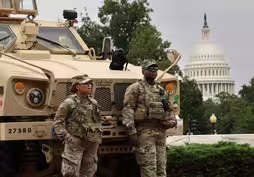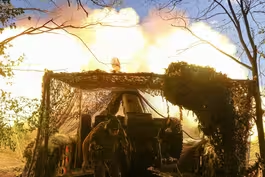
Why firefighters face toxic smoke with little protection
Clip: 8/19/2025 | 6m 17sVideo has Closed Captions
Why firefighters are facing toxic smoke with little to no protection
At the height of wildfire season, thousands of firefighters regularly face a host of dangers on the frontline, including confronting toxic smoke. As seasons grow longer and more intense, the health of wildland firefighters is under renewed focus. Stephanie Sy spoke with Hannah Dreier of The New York Times about her report on major health issues firefighters are facing.
Problems playing video? | Closed Captioning Feedback
Problems playing video? | Closed Captioning Feedback
Major corporate funding for the PBS News Hour is provided by BDO, BNSF, Consumer Cellular, American Cruise Lines, and Raymond James. Funding for the PBS NewsHour Weekend is provided by...

Why firefighters face toxic smoke with little protection
Clip: 8/19/2025 | 6m 17sVideo has Closed Captions
At the height of wildfire season, thousands of firefighters regularly face a host of dangers on the frontline, including confronting toxic smoke. As seasons grow longer and more intense, the health of wildland firefighters is under renewed focus. Stephanie Sy spoke with Hannah Dreier of The New York Times about her report on major health issues firefighters are facing.
Problems playing video? | Closed Captioning Feedback
How to Watch PBS News Hour
PBS News Hour is available to stream on pbs.org and the free PBS App, available on iPhone, Apple TV, Android TV, Android smartphones, Amazon Fire TV, Amazon Fire Tablet, Roku, Samsung Smart TV, and Vizio.
Providing Support for PBS.org
Learn Moreabout PBS online sponsorshipAMNA NAWAZ: At the height of wildfire season, thousands of firefighters regularly face a host of dangers on the front lines.
That includes confronting toxic smoke, sometimes with little to no protection.
And a new report says the effects can be dire.
Stephanie Sy has our look.
STEPHANIE SY: For years, the Forest Service has fought against efforts to better protect firefighters from toxic smoke, resisting recommendations to provide masks.
That's according to a new investigation from The New York Times.
As wildfire seasons grow longer and more intense, the health of wildland firefighters is under renewed focus.
Hannah Dreier reported this story for The New York Times and joins me now.
Hannah, thank you so much for joining the "News Hour."
So I understand you spoke to more than 250 firefighters for this report.
You were on the fire lines, and many of these firefighters you highlighted in the piece had major health issues.
So tell us, what kinds of patterns and similarities did you see among their illnesses and their links to wildfire smoke?
HANNAH DREIER, The New York Times: So I was shocked to find out that tens of thousands of wildfire fighters go out for weeks and months at a time in toxic smoke with no protection, no masks.
And, like you, say what I found is that many of them are getting very sick.
So I'm talking about otherwise healthy people who are developing rare cancers in their 20s.
These men are dying of cancer in their 30s.
They're being told by doctors in their 30s that they have ground-glass nodules in their lungs, that their lung tissue is dying.
And some of the people I spoke to are being told in their 40s that they now need double lung transplants.
And this is all illnesses associated with smoke.
STEPHANIE SY: Of course, it's always hard to prove cause and effect when it comes to these health issues, but there were a lot of studies that you looked at that showed the links between toxic smoke and certain cancers.
You also reported, Hannah, that the Forest Service does not only not provide respiratory masks to these firefighters.
They aren't allowed to wear masks on the fire line?
Why is that?
HANNAH DREIER: That's right.
I mean, any other kind of firefighter, it would be unthinkable that they would go into a burning building without that mask and compressed air tank that we all know so well.
But for these guys who are out fighting wildfires, they are not supposed to wear masks.
They're told not to wear masks, even if they want to go and buy their own.
And the Forest Service, which employs most of the wildfire firefighters, says that that's because they worry about heat stress.
They worry that, if these guys had masks on, they might get heatstroke.
But, in other countries, wildland firefighters now do wear masks, and there have not been upticks and heatstroke at all.
We have internal documents where the Forest Service is saying, if these people wore masks, they might be less productive.
They might not work.
They might work only 80 percent as hard as they're working now.
And people who have worked in the agency say that that's part of what is actually going on here.
We also talk to people who spent years at the agency, and they say that if the Forest Service were to allow firefighters to wear masks, it would mean admitting that smoke is dangerous.
And that could cause a huge rethinking of the whole way the agency works right now.
It could be very expensive.
They could have to take lots of other steps to protect these guys from smoke exposure and ultimately hire more crews and spend more money.
STEPHANIE SY: And we know with our own reporting here at PBS that firefighters in the Forest Service in particular are already really short-staffed among wildland firefighters.
But you spoke to firefighters for this piece.
I have spoken to firefighters who simply don't like wearing them.
They describe them as hot and cumbersome,the types of masks that you just described urban firefighters wearing really, really difficult in wildfire conditions.
And then there's the culture of not wearing them.
So even if they were to change the guidance, even if they were to provide masks, did you get a sense that it would make a difference?
HANNAH DREIER: There is a cultural resistance to masks, absolutely.
This is a pretty macho culture.
It's a culture where people are trying to prove how tough they are and how they're not going to let down their teammates when they're out on a fire.
But what we have seen in other countries that now hand out these masks is that culture can change pretty quickly.
And nobody's talking about wearing a mask 16 hours a day.
People put these masks on when it's smoky, take them off when it's not.
They can take them off when they're doing very physical work.
But what I saw as spending time on the fire lines is that a lot of what they're doing is actually standing right next to a fire in the worst smoke conditions just watching the fire, making sure it doesn't jump the fire line.
And that's exactly when people are wearing these masks in other places.
STEPHANIE SY: Part of the problem is also the lack of long-term data on the health impacts of wildfire smoke on the entire firefighter population.
Is that what has to also change?
And how likely is that to change under the current federal government?
HANNAH DREIER: It's a really tough thing.
I mean, there's decades of studies that show that wildfire smoke in general can be harmful to your health, is associated with cancer, with lung damage.
But there are very few studies looking specifically at wildfire firefighters.
And part of that, again, goes back to what's been going on at the Forest Service.
They have been told for 25 years to start that kind of study.
This work actually did get started in 2023.
The federal government launched a cohort study of firefighters.
Unfortunately, in the first months of the Trump administration, all of the people doing that work were laid off.
Some of them have now been brought back, but they say that the work really remains disrupted.
STEPHANIE SY: That is Hannah Dreier with The New York Times joining us.
Hannah, thank you.
HANNAH DREIER: Thank you.
Book explores James Baldwin's life through his relationships
Video has Closed Captions
Clip: 8/19/2025 | 7m 25s | 'Baldwin: A Love Story' frames James Baldwin's life through the lens of his relationships (7m 25s)
Climate and market factors drive beef prices to record highs
Video has Closed Captions
Clip: 8/19/2025 | 7m 36s | The climate and market factors driving beef prices to record highs (7m 36s)
A look at D.C. crime as Trump and city give competing claims
Video has Closed Captions
Clip: 8/19/2025 | 8m 49s | A look at D.C. crime stats as Trump and city leaders offer competing claims (8m 49s)
News Wrap: Trump administration revokes security clearances
Video has Closed Captions
Clip: 8/19/2025 | 6m 21s | News Wrap: Trump administration revokes security clearances of current, former officials (6m 21s)
Russian propaganda finds support among U.S. religious right
Video has Closed Captions
Clip: 8/19/2025 | 7m 14s | Russian propaganda finds sympathetic ears among U.S. religious right (7m 14s)
Ukraine's former foreign minister warns Putin won't give up
Video has Closed Captions
Clip: 8/19/2025 | 8m 12s | Putin 'won't give up on trying to destroy' us, Ukraine's former foreign minister warns (8m 12s)
Providing Support for PBS.org
Learn Moreabout PBS online sponsorship
- News and Public Affairs

FRONTLINE is investigative journalism that questions, explains and changes our world.

- News and Public Affairs

Amanpour and Company features conversations with leaders and decision makers.












Support for PBS provided by:
Major corporate funding for the PBS News Hour is provided by BDO, BNSF, Consumer Cellular, American Cruise Lines, and Raymond James. Funding for the PBS NewsHour Weekend is provided by...





